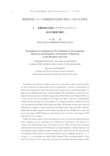荒廃林地の回復とアグロフォレストリー ー林内光環境の解析ー
国際農林水産業研究センター研究会報告集
| ISSN | 13406094 |
|---|---|
| NII recode ID (NCID) | AN10446728 |

Full text
wspaper2-_4-16.pdf2.25 MB
1)アグロフォレストリーにおける林木一作物混植による光エネルギーの効率的利用法を検討するため,造林樹種の葉の光特性と林内光環境の解析を試みた。2)樹木の葉を透過した光の波長別エネルギー組成は,全天日射のそれとは著しく異なり,400 ~ 700nmの光合成有効放射領域でのエネルギー吸収が顕著であるが,700nm以上の遠赤色光域での吸収は少ない。3)葉透過光の光合成有効放射束密度(FFPD)は,全天日射に対する相対値でみると,1.2~12.5%の範囲にあり,樹種により異なることがわかった。4)葉の透過光の波長別エネルギー組成は,その時の日射の影響を受け雲に遮蔽された散乱光の条件下では,その時の雲の状態に大きく影響される。5)透過光のエネルギー組成は,透過する葉の量によっても異なる。透過葉数が増えるに伴い透過率は著しく低下し,特に光合成有効放射領域での減衰が顕著である。6)葉の加齢に伴い,透過率も変化する。一般に,幼葉では光合成有効放射領域の透過率が成葉に比べて高く,老葉では逆に低くなる。しかし,これは樹種により異なり,種の特性と考えられる。7)葉の表面で反射した光の波長別エネルギー組成も全天日射とは大いに異なる。400nm以下,及び700nm以上の波長域での反射率が著しく,400~700nmの波長域での反射率は0.8~12%の範囲で比較的安定している。反射率についても樹種による違いが認められる。8)林内光環境を解析するため,林内散光の波長別エネルギー組成を測定した。その結果,散光のエネルギー組成は全天日射,葉の透過・反射光のそれとは著しく異なり,700nm以下の波長域の透過率は低く,且つほぼ一定で安定している。一方,700nm以上の波長域では透過率が高い。林内散光についても,林冠を構成する樹種による違いが認められた。9)林内の光環境は樹種,植栽間隔等により異なり,また林齢,季節等によっても変動する。樹種,植栽間隔,林齢と林内光環境とは密接な関係にあり,植栽密度が高いほど林内の散光量の低下が早くから起こり,林齢が進につれて一層光量不足が加速される。光量低下の程度と速度は林分を構成する樹種によっても異なる。林内の光環境は単一葉の光特性の他に,特に林冠構造が重要で,林内相対照度と林冠の開空率との聞には密接な関係が認められる 10)林内光環境の季節変動は,林冠を構成する樹種のフェノロジーに依存し,雨期と乾期の明瞭な熱帯モンスーン地域では,林木と作物の生長期が一致するため,作物栽培期には林内光環境は作物の生育には必ずしも適した状態とはいえない。11)林内光環境は林冠を構成する葉の光特性,特に葉量,樹冠構造,植栽間隔及び林冠閉鎖の程度等と密接な関係にある。林内の光環境は林分により異なり,樹種,植栽間隔,林齢等により変動することから,栽培目的に合わせた保育形式と,下層に栽培する作物種を考慮する必要がある。The quality and quantity of light energy were analyzed in order to study its effect on the production of agricultural crops in agroforestry systems. Transmittance of leaves was measured in about 50 species and the spectrum of transmitted light of a leaf was very different from that of solar radiation. The absorbance of a leaf was very high for blue, green and red light, ranging from 400 to 700 nm wavelength (PAR), but it was low for the far red light in the range from 700 to 1100 nm. Transmittance varied with the leaf age and it was higher in a young leaf than in a mature or an old one for green and red light in the range from 500 to 700 nm but it was lower in an old leaf than in a young or a mature one for far-red light in the range from 700 to 1100 nm. Reflectance of light energy on a leaf surface was higt for far-red light but it was very low in the range of PAR. However, transmittance was very low in the range of PAR and high for far-red light.
Under the closed canopy of fast-growing trees, most of the natural radiation (direct solar radiation and sky radiation) was reflected and absorbed by the leaves of a canopy.The diffused light under the canopy was very different from that of natural radiation and the spectrum exhibited a low and approximately constant energy at all wavelengths. Light conditions under a canopy also varied with the tree age and with the spacing of tree stands. In Acacia auriculiformis and A. mangium stands at 2 x 2 m and 2 x 4 m spacings, the relative light intensity (RLI) decreased rapidly to less than 20 % three or four years after the trees were planted and the decrease of RLI continued gradually with tree growth subsequently. In the A. leptocarpa stands planted at 2 x 2 m, 2 x 4 m and 2 x 6 m spacings, a large amount of energy of diffused light was observed at all wavelenghts in the stands with a wider spacing. Relative light intensity under the canopy was closely related to the area of an opening in the canopy but not with the reflectance or transmittance in a leaf. This fact suggests that the light conditions under a canopy depend on the structure of the
stand.
Under the closed canopy of fast-growing trees, most of the natural radiation (direct solar radiation and sky radiation) was reflected and absorbed by the leaves of a canopy.The diffused light under the canopy was very different from that of natural radiation and the spectrum exhibited a low and approximately constant energy at all wavelengths. Light conditions under a canopy also varied with the tree age and with the spacing of tree stands. In Acacia auriculiformis and A. mangium stands at 2 x 2 m and 2 x 4 m spacings, the relative light intensity (RLI) decreased rapidly to less than 20 % three or four years after the trees were planted and the decrease of RLI continued gradually with tree growth subsequently. In the A. leptocarpa stands planted at 2 x 2 m, 2 x 4 m and 2 x 6 m spacings, a large amount of energy of diffused light was observed at all wavelenghts in the stands with a wider spacing. Relative light intensity under the canopy was closely related to the area of an opening in the canopy but not with the reflectance or transmittance in a leaf. This fact suggests that the light conditions under a canopy depend on the structure of the
stand.
| Alternative title | Degraded forest lands in the tropics and agroforestry -Analysis of light conditions under a canopy of fast-growing trees- |
|---|---|
| Date of issued | |
| Creator | 中島清 |
| Publisher | 農林水産省国際農林水産業研究センター |
| Available Online | |
| Type | Conference Paper |
| Volume | 2 |
| spage | 4 |
| epage | 16 |
| Language | jpn |
